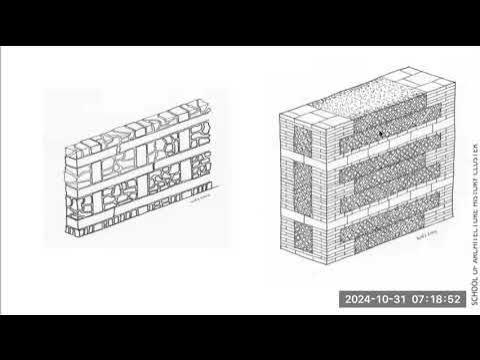Was Roman Concrete Better?
Summary
TLDRIn this Practical Engineering episode, Grady explores the longevity of concrete structures, contrasting the ancient Roman Pantheon's dome with modern infrastructure. He discusses the importance of concrete reinforcement with steel, its weaknesses like rust and expansion, and how Romans avoided these issues by omitting steel and utilizing structural designs like arches and domes. The video also touches on Roman concrete's chemical composition, modern concrete mix design advancements, and the role of chemical admixtures like superplasticizers. Grady concludes by pondering the economic factors affecting concrete lifespan and the potential for modern concrete to surpass Roman durability.
Takeaways
- 🏛 The Pantheon in Rome boasts the largest unreinforced concrete dome, showcasing the durability of ancient Roman concrete structures.
- 🏗 Modern infrastructure often requires reinforcement with steel due to tensile stress, which can lead to rusting and structural deterioration over time.
- 🛠 The Romans avoided using steel in their concrete, instead relying on structural engineering techniques like arches and domes to maintain compression and minimize tensile stress.
- 🌋 Roman concrete was found to contain a unique combination of materials, including seawater and volcanic ash, which contributed to its exceptional durability.
- 🔬 The science of concrete mix design has advanced, allowing for the creation of concrete with improved properties through careful control of the water-to-cement ratio.
- 🚧 Roller Compacted Concrete (RCC) is a modern method that mimics ancient Roman techniques, using less water and often incorporating ash to create a strong, dry mix suitable for large structures.
- 🧪 Chemical admixtures, such as superplasticizers, are used in modern concrete to improve workability and strength, allowing for lower water content and higher strength without compromising pourability.
- 💰 Economic factors play a significant role in the design life of concrete structures, with engineers often balancing the need for durability against cost constraints.
- 🏙 The design of modern concrete structures like overpasses and skyscrapers necessitates a balance between workability, strength, and the use of reinforcement to handle complex forms and loads.
- ⏳ The longevity of modern concrete structures is still uncertain, as they have not been tested over the same extended time periods as ancient Roman constructions.
Q & A
What is the largest unreinforced concrete dome in the world?
-The largest unreinforced concrete dome in the world is on the Pantheon, an ancient Roman temple.
Why does modern infrastructure often appear to deteriorate more quickly compared to ancient Roman structures?
-Modern infrastructure may appear to deteriorate more quickly due to factors such as the use of steel reinforcement which can rust and cause damage, and the economic pressures to build structures that meet design requirements at a lower cost.
What is the primary reason for using steel reinforcement in concrete?
-Steel reinforcement is used in concrete to provide strength against tensile stress, as concrete alone is strong in compression but weak in tension.
How did the Romans manage to avoid using steel reinforcement in their concrete structures?
-The Romans avoided using steel reinforcement by employing clever structural engineering tricks such as arches and domes, and by making their structures massive to keep the concrete in compression.
What is the significance of the water-to-cement ratio in concrete?
-The water-to-cement ratio is significant because too much water dilutes the cement paste, weakening the concrete. The Romans and modern practices like Roller Compacted Concrete aim to minimize water content for stronger concrete.
What is Roller Compacted Concrete (RCC) and how does it relate to Roman concrete techniques?
-Roller Compacted Concrete (RCC) is a modern construction material that uses less water and includes ash, similar to Roman concrete. It is compacted into place using heavy equipment and is often used in large gravity and arch dams.
How do chemical admixtures like superplasticizers improve modern concrete?
-Chemical admixtures like superplasticizers improve modern concrete by allowing it to remain workable with lower water content, which results in a stronger final product without compromising the ease of handling during construction.
What role does economics play in the design life of concrete structures?
-Economics plays a significant role in the design life of concrete structures as engineers must balance the need for durability with the cost constraints, often leading to designs that meet minimum standards rather than 'Roman' standards of longevity.
How does the technology of concrete mix design compare between ancient Roman times and today?
-The technology of concrete mix design has advanced significantly from ancient Roman times to today, with modern engineers having a wide variety of admixtures and precise control over the mix to create concrete with specific properties.
What is the role of tensile stress in the need for reinforcement in concrete structures?
-Tensile stress plays a critical role in the need for reinforcement in concrete structures because concrete is weak in tension. Reinforcement materials like steel provide the necessary tensile strength to prevent cracking and failure.
How do modern concrete structures handle the lack of tensile strength in concrete?
-Modern concrete structures handle the lack of tensile strength by using reinforced concrete, where steel bars or other materials are embedded to provide the necessary tensile strength, or by designing structures to minimize tensile stress through shape and weight.
Outlines

This section is available to paid users only. Please upgrade to access this part.
Upgrade NowMindmap

This section is available to paid users only. Please upgrade to access this part.
Upgrade NowKeywords

This section is available to paid users only. Please upgrade to access this part.
Upgrade NowHighlights

This section is available to paid users only. Please upgrade to access this part.
Upgrade NowTranscripts

This section is available to paid users only. Please upgrade to access this part.
Upgrade Now5.0 / 5 (0 votes)





